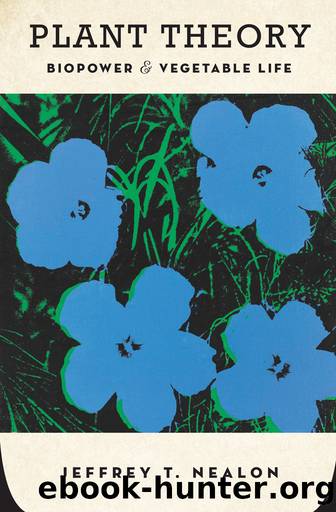Plant Theory by Nealon Jeffrey T

Author:Nealon, Jeffrey T. [Nealon, Jeffrey T.]
Language: eng
Format: epub
Publisher: Stanford University Press
Published: 2015-06-14T16:00:00+00:00
4
FROM THE WORLD TO THE TERRITORY
Vegetable Life in Deleuze and Guattari; or, What Is a Rhizome?
ASKING “WHAT IS A RHIZOME?” in Deleuze and Guattari may seem like a flat-footed, wrongheaded, or merely superfluous question for one or several reasons. First, the rhizome in Deleuze and Guattari covers territory that’s been very thoroughly commented on, maybe even buried under scholarship, in the past couple of decades. So, really, what’s left to say about the rhizome (or, one might wonder, about any of the foundational Deleuzoguattarean concepts)? Second, the Aristotelian form of the question itself (“what is x?”) may seem hopelessly old-fashioned, despite Deleuze and Guattari’s attraction to this very phrasing—in their last work, for example, What Is Philosophy? Besides, as I noted with the first objection, we already know full well what the rhizome is: multiple, intense, subterranean, resistant, connective, smooth, molecular, a block of becoming. (And thereby we also know what it’s not: totalized, extensive, arborescent, compliant, closed, striated, molar, a block of being.) What is a rhizome? Quite simply, it can seem like the rhizome is one-stop shopping for all your deterritorialization needs. As Elaine Miller writes in Vegetative Soul, “Rhizomes have no territory; they may spread with the wind and cover any amount of ground, since they grow outward rather than upward.”1
Against this grain I’m going to stress here that the rhizome is equally (and in fact more importantly) a matter of territorialization, mapping a way of inhabiting territory—of “living”—that’s crucially different from the fictional phantasms that Derrida sees as necessary to any living being’s “world.” Rhizomatics constitutes a style of conceptual personae, in Deleuze and Guattari’s sense: a field of forces that dramatizes a new image of thought and concept of life, outside the organism-centered, human-animal understandings of life that continue to dominate our biopolitical present.2
And there’s perhaps an even more awkward consequence to raising the question “What is a rhizome?” at this point in our investigation: the rhizome seems the obvious place to begin, rather than end, a book concerned with plant life in Foucault, Derrida, and Deleuze and Guattari. I hope I’ve managed to shed some obscure light on the myriad roles of vegetable life in selected texts written by Foucault, Derrida, and some of their interlocutors (Agamben and Heidegger, among others). But surely it’s not going to be difficult to demonstrate a foundational debt to plants in Deleuze and Guattari’s work: the rhizomatic life of plants is nothing less than the opening gambit and the virtual map to their most famous work, A Thousand Plateaus. “Introduction: Rhizome” is the plateau that you read first and is in fact the chapter that says, when you’re done with it, you can read the rest of the book in any order you like.3
In short, Deleuze and Guattari’s engagement with plant life does not, unlike Foucault’s or Derrida’s, seem to require much unearthing or unpacking. The centrality of vegetable life hardly remains obscure or hidden in a discourse that urges us straightforwardly to “Follow the plants” (TP 11), even though “it’s not easy to see the grass in things” (TP 23).
Download
This site does not store any files on its server. We only index and link to content provided by other sites. Please contact the content providers to delete copyright contents if any and email us, we'll remove relevant links or contents immediately.
| Aeronautics & Astronautics | Astronomy |
| Astrophysics & Space Science | Comets, Meteors & Asteroids |
| Cosmology | Mars |
| Solar System | Star-Gazing |
| Telescopes | UFOs |
Tools of Titans by Timothy Ferriss(8305)
Turbulence by E. J. Noyes(7980)
Secrets of Antigravity Propulsion: Tesla, UFOs, and Classified Aerospace Technology by Ph.D. Paul A. Laviolette(5333)
Astrophysics for People in a Hurry by Neil DeGrasse Tyson(5151)
Room 212 by Kate Stewart(5072)
Design of Trajectory Optimization Approach for Space Maneuver Vehicle Skip Entry Problems by Runqi Chai & Al Savvaris & Antonios Tsourdos & Senchun Chai(5037)
Pale Blue Dot by Carl Sagan(4957)
The David Icke Guide to the Global Conspiracy (and how to end it) by David Icke(4657)
A Journey Through Divination and Astronomy by Publishing Pottermore(4363)
Goodbye Paradise(3763)
Apollo 8 by Jeffrey Kluger(3668)
COSMOS by Carl Sagan(3589)
The Five People You Meet in Heaven by Mitch Albom(3520)
Losing the Nobel Prize by Brian Keating(3518)
How to Read Water: Clues and Patterns from Puddles to the Sea (Natural Navigation) by Tristan Gooley(3433)
Brief Answers to the Big Questions by Stephen Hawking(3393)
How to Read Nature by Tristan Gooley(3292)
The Order of Time by Carlo Rovelli(3162)
A Brief History of Time by Stephen Hawking(2992)
